声のかたちを求めて
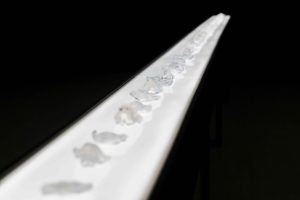
レコーダーに録音された自分の声を聴いたとき、自分の声なのにまるで知らない声を聴くようだった。自分の顔が自分で見えないように、自分の声は自分で聴くことができないらしい。自分の身体はときに想像もしない現象やかたちをもたらす不可思議な存在である。
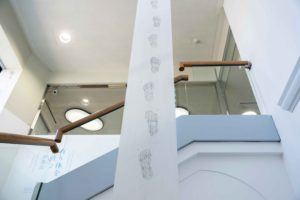
尼崎のA-LABで開催された第一回白髪一雄現代美術賞受賞者展として開催された林葵衣の個展「有り体を積む」は、作家の足や唇、声や筆跡など、思いもよらない身体の「かたち」に満ちていた。
展示は足跡からはじまる。林が尼崎の各所を素足で歩き、地面をフロッタージュした《裸足の地図 -尼崎-》、続くROOM1と和室には博物標本や鉱物のように小さく透明な塊がライトボックスに並ぶ。「Phonation piece」と題されたこのシリーズは、作家がポリエチレン樹脂を口に含み、ひらがなの50音や尼崎ゆかりの詩人杉山平一(1914-2012)の詩を口内で発話し、型取りした「声」のかたちである。作家の口内を型取りして生まれた身体的、官能的な光り輝く美しい「かたち」が鮮烈だ。
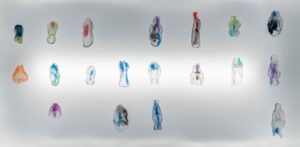
ロビーや廊下の窓ガラスと壁面には口紅の跡がある。これらは尼崎の人々との対話や窓から見えたものや音を、口紅を塗った唇を壁や窓に押し当てて発話した痕跡である。鑑賞者は、知らない言葉を解読するように窓や壁を眺める。ROOM3にはRとEのスタンプを画面中央に引いた線に沿って押印し、文字の崩れを観察する初期の絵画「繰り返しくずれる」シリーズが展示された。
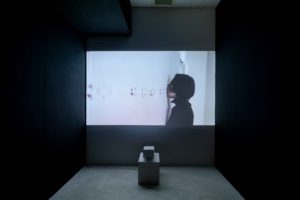
以上のように、本展では開催地である尼崎の歴史や人々、風景などを声や言葉、身体や発話によるズレと反復によって現した作品が並んだ。林の作品は、口内や口紅跡など、身体性が印象に残る作品である。だが、これらの作品の根底にあるのは、本展に展示された絵画のタイトルが示しているように、「繰り返し」と「くずれる」にある。
例えば、初期作から新作まで一貫しているのは、足や唇、声のかたち、スタンプが連続していることだ。「Phonation piece」の音は整列し、《Phonation -Dialog-》の口紅跡の発話は横に連なる。つまり、同じ箇所に続けて発話するのではなく、一音一音に異なる場所が与えられ、連続した音節、文章となるように音(声)を残しているのだ。
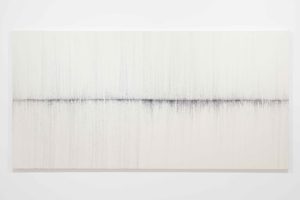
「有り体を積む」と題された本展で、林は一か所に発話を積み上げるのではなく、空間に水平的に連続、反復して発話する。それは、発話や言葉のかたちを可読可能にするためだろうか。だが、その「声のかたち」が言語として理解できるかは読心術の心得があっても難しいだろう。つまり、林は発話をラインとして繰り返すことで声のかたちや言葉の意味が「くずれる」さまを見せようとしているのではないか。それは、発話のイントネーションや間、パフォーマンスや鑑賞=読書という身体の移動も含めてこのような技法(文法)に到達したのではないだろうか。
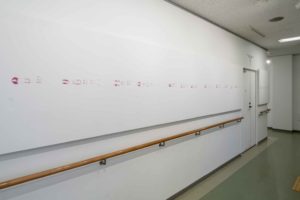
林の口紅の痕跡が残すかすれや発話のくずれは、李禹煥の線や点が掠れていく絵画シリーズ「線より」、「点より」シリーズの反復と差異、集積を想起するかもしれない。だが、林の制作においては、身体や場所性を通じて思いもよらない、見えない「声のかたち」を捉えようとしているように思える。
ここで林と対比的に位置づけてみたいのは野村仁である。野村は五線譜を写し込んだフィルムで月を連続撮影した《’moon’ score》(1975-)や音声を使った「聴覚映像」と呼ぶ作品を通じて、「意志とかかわりの無い形態」を探究してきた。
野村のデビュー作である遅延論を意味する《Tardiology》(1969)は、高さ8メートルに組み上げたダンボールが自重で崩壊していく様子を記録した写真作品である。本作で、「意志とかかわりの無い形態」に気づいた野村は、以後も写真を媒体に昇華して小さくなっていくドライアイスの重量と時刻を記して連続撮影した《Dryice: 1969》(1969)をはじめ、路上の日時、太陽や月の運行など、自然現象や物質の移行や消失、ズレを写真で記録していく。
また、1970年代に音を素材に制作された「HEARING」シリーズでは、商品を購入する際の会話を録音してカセットやレコード化し、さらに会話を台本に書き起こした。また京都国立近代美術館に向かう道すがら《公衆電話を使って、その位置から磁石の指し示す北の方角に見える全てをそのまま、075-76-4113へ報告する》(1970)パフォーマンスの録音と記録写真などがある。[1]
以上、野村と林はモチーフに天体と身体という違いがあるが、どちらも変容し、消えていく現象を観測・記録した点で共通性がある。また、日常の音声や会話の記録を素材とした野村の「HEARING」シリーズと林の本展展示作、野村の《Tardiology》と林の「繰り返しくずれる」シリーズには、彫刻と文字が重力と身体によって崩れるさまが記録され、ズレや変容への関心を確認できるだろう。
一方、両者の違いは、野村が視覚的な「見る」、林は聴覚的な「聞く、話す」行為が制作の根底にある。野村の音声をモチーフとした作品は、内容や場所性よりは音声記録を異なる記憶媒体へと拡張していく作品だった。対して、林は身体と物質、場所との関わりから、声や言葉を記録していくことに特徴がある。
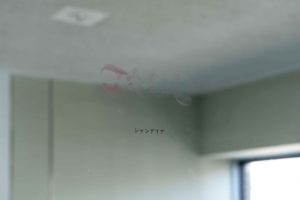
こうした林の作品は、スタジオなどの録音環境とは異なる場所の音を録音するフィールド・レコーディングの言葉でいう「フォノグラフィー(phonography)」の実践と呼べるだろう。[2] その語源は、ギリシア語で「音」や「声」を意味するphoneと「書くこと」を意味するgrapheを組み合わせた造語である。[3] 野村の客観的な写真(photography)と異なり、林は主観的な身体によるフォノグラフィーによって、音声を視覚化しているのだ。林の声の探究はどのフィールドへと向かうのか。その音声はおそらく私たちがはじめて知る「声のかたち」だろう。さらなる「音」の記述に眼を澄ましたい。
平田 剛志 (美術批評)
(2023.07.10)
撮影|守屋友樹
[1] 金子智太郎「別物になる音—1970年代における野村仁の『聴覚映像』」日本美術サウンドアーカイブ、2018、https://japaneseartsoundarchive.com/jp/texts/leaflet4-2/(2023年7月11日参照)
[2] 林は藤本由紀夫を中心に音と文字、グラフィックスを実験的な表現で探求するユニット「phono/graph」にも参加している。ユニット名は、蓄音機を意味する「phonograph」に由来する。ユニットでの発表が林にもたらした影響については今後の課題としたい。
[3] 柳沢英輔『フィールド・レコーディング入門――響きのなかで世界と出会う』フィルムアート社、2022.4、52頁。
Aoi Hayashi Layering Behaviors
Pursuing for the Shape of Voice
Takeshi Hirata
When I listened to my own voice recorded on the recorder, it seemed that I heard a voice I never knew even though it was mine. Just as we can’t see our own face, it appears we cannot hear our own voice. Our body is a mysterious existence that brings about unimaginable phenomena and shapes.
The solo exhibition “Layering Behaviors,” by Aoi Hayashi, held at A-LAB in Amagasaki as the first recipient of the Kazuo Shiraga Contemporary Art Award, is filled with unexpected “shapes” of her body such as her feet, lips, voice, handwriting, and more.
The exhibition begins with footprints. Hayashi walked barefoot across various places in Amagasaki, using frottage to create “Hadashi no Chizu – Amagasaki.” Moving on to ROOM 1 and a traditional Japanese room, small transparent clusters resembling natural history specimens or minerals are lined on lightboxes. This series, titled “Phonation Piece,” involves the artist placing polyethylene resin in her mouth and orally expressing the hiragana syllabary and poems related to Amagasaki by poet Heiichi Sugiyama (1914-2012). The resulting molds represent the shapes of “voices.” The artist’s bodily, sensual, and radiant “shapes” created by molding her oral cavity are remarkably vivid.
There are lipstick marks on the windows and walls in the lobby and hallways. These marks are traces of utterances by Hayashi during conversations with people from Amagasaki, things seen through windows, and sounds heard. Her lipstick-coated lips were pressed against the walls and windows, leaving behind a remnant of the act of uttering. Visitors gaze at the windows and walls as if attempting to decipher unfamiliar words. In ROOM 3, the exhibition featured the series ‘Kurikaeshi Kuzureru,’ which is one of Hayashi’s early artworks exploring the distortion of letters. The series consists of words stamped with R and E stamps along a line drawn in the center of the canvas, highlighting the imbalance.
As described above, this exhibition showcases works that depict the history, people, landscapes, and more of Amagasaki, the hosting location. These artworks are presented through deviations and repetitions of voices, words, bodily actions, and utterances. Hayashi’s works are memorable for their embodiment, including pieces that involve elements like the mouth and lipstick traces. However, underlying these artworks is the essence of ‘repetition’ and ‘imbalance,’ as suggested by the titles of the paintings exhibited in this show.
For instance, what remains consistent from the early works to the new ones is the continuity of elements like feet, lips, voice shapes, and stamps. In ‘Phonation piece,’ the sounds are aligned in a sequence. In ‘Phonation -Dialog-,’ the utterances marked by lipstick traces are arranged horizontally. In other words, rather than uttering in the exact same spot, each sound is assigned a distinct location to create a continuous flow of syllables and sentences.
In her exhibition titled ‘Layering Behaviors,’ Hayashi employs a technique where she doesn’t accumulate utterances in a single location; rather, she utters them sequentially and repetitively in a horizontal manner throughout the space. Could this be an effort to make the shapes of utterances and words more readable? However, comprehending the “shape of voices” as language remains challenging, even with proficiency in mind reading. Is Hayashi attempting to demonstrate that the ‘shape of voices’ and the meaning of words become ‘imbalanced’ through the repetition of uttered phrases? Could it be that she has arrived at employing such techniques (grammar), involving not only the physical movement of intonations and pauses in utterances but also performance and the act of reading?
The fading of Hayashi’s lipstick traces and the distortion in her utterances might evoke Lee Ufan’s painting series, ‘From Line’ and ‘From Point.’ These series share elements of repetition, differences, and accumulation, reminiscent of Hayashi’s approach. However, in Hayashi’s creative process, it appears she seeks to capture the unimaginable and invisible “shape of voice” through the embodiment of physicality and the context of location.
In this context, we can draw a contrasting comparison with Hitoshi Nomura. Nomura has explored the concept of ‘form unrelated to will’ through works such as “‘moon’ score [1975-],” where he continuously photographed the moon using film imprinted with musical staff notation, and his artworks categorized as ‘auditory-images,’ which combine sounds and visual elements.
Hitoshi Nomura’s debut work, “Tardiology” (1969), signifies a photographic portrayal capturing the gradual collapse of an 8-meter-high stack of cardboard boxes under their own weight. This artwork embodies the essence of ‘tardiology.’ Nomura’s insights into the ‘form unrelated to will’ were sparked by this creation. Subsequently, he continued to explore the medium of photography, initiating projects like “Dryice: 1969” (1969), a series of continuous photographs documenting the weight and time-related shrinkage of dry ice. His photographic pursuits encompassed various natural phenomena—ranging from documenting street timeframes, solar and lunar trajectories, to capturing shifts, transitions, and disappearances of substances—all through the lens of photography.
Furthermore, in the “HEARING” series created using sound as material during the 1970s, conversations during purchase were recorded and then dubbed onto cassette tapes and vinyl records. Additionally, these conversations were transcribed into scripts. The collection also includes a recording of the performance and photographic documentation of the artwork made on the way to The National Museum of Modern Art, Kyoto. The artwork was dubbed onto a vinyl record and titled “Telephone Eyeshot (1970)”.
There are the difference in motif such as celestial bodies for Nomura and body parts for Hayashi, but we can see the commonalitis as in observation and records of variance and dissapearance of phenomina. Also, in HEARING series and Hayashi’s artworks, and in Nomura’s ‘Tardiology’ and Hayshi’s ‘Kurikaeshi Kuzureru’series, The interest in variance and differences is recognized by recording how sculpture collapse by its own weight and how words imbalance by body parts.
Though Nomura and Hayashi differ in their choice of motifs—celestial bodies for Nomura and body parts for Hayashi—both artists share a commonality in observing and recording phenomena that undergo transformation and disappearance. Furthermore, in Nomura’s “HEARING” series, which employs everyday sounds and conversations as material, and in Hayashi’s exhibited works, as well as in Nomura’s “Tardiology” and Hayashi’s “Kurikaeshi Kuzureru” series, we can observe their shared interest in shifts and transformations. These works capture the way sculptures and words are affected by gravity and the body.
Conversely, the distinction between the two lies in the fact that Nomura’s works are rooted in visual actions of “seeing,” while Hayashi’s are grounded in auditory actions of “hearing” and “speaking.” Nomura’s works, which take sound as their motif, extend audio recordings into various memory mediums, diverging from the realm of content and location. In contrast, Hayashi’s distinctive approach involves recording voices and words within the context of the interplay between body, substances, and surroundings.
Such works by Hayashi could be considered as the practice of “phonography,” a term used in field recording to denote recording sounds from environments different from studio settings. The term originates from the Greek words ‘phone,’ meaning ‘sound’ or ‘voice,’ and ‘graphe,’ meaning ‘writing.’ In contrast to Nomura’s objective photography, Hayashi employs subjective bodily phonography to visualize sound. Where will Hayashi’s exploration of voice lead? Her sound might likely represent the very “shape of voice” we are encountering for the first time. I am eager to cast a discerning ‘eye’ on the further descriptions of “sound”.
(Takeshi Hirata|Art Critic)
(Kazumasa Ueda|Translator)
